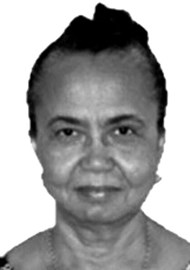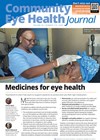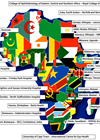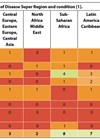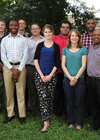The VISION 2020 LINKS & Networks Programme has been writing regular articles in Eye News about its capacity-strengthening activities in low- and middle-income countries (LMICs) for more than a decade. This, the first International Issue, is a landmark for Eye News, enabling further learning about developments in eye care in LMICs. It is also an ideal opportunity to expand on the wider work of the International Centre for Eye Health (ICEH), where the LINKS & Networks Programme is based.
Introduction
The ICEH has been at the forefront of education and research in public health eye care since its establishment by Barrie Jones in 1981 [1]. Its subsequent leaders have been Gordon Johnson (1986-2002), Allen Foster and Clare Gilbert (2002-2020) and Matthew Burton (2020-present). Over the last 40+ years, the mission of ICEH has been to improve eye health worldwide by working with partners in LMICs. Chronic shortage of human resource is one of the key health issues facing LMICs. ICEH aims to address this by helping leaders in eye health to better understand and address the eye care needs they face in their countries.
Today, many of the leaders in eye health all over the world are alumni of the masters course in Public Health for Eye Care at ICEH [2]. Many have established hubs of research and have developed local and national eye health programmes that have increased service delivery and reduced blindness in LMICs. Many have continued to work with ICEH, helping to ensure that the research, teaching and capacity-strengthening carried out by ICEH and its collaborators is relevant and timely, and is embedded within LMIC national Ministry of Health (MoH) priorities, frameworks and programmes.
This is where ICEH differs from other institutions in this field – it weaves together its people (alumni, collaborators, staff, students) with its activities (knowledge generation, capacity-strengthening, policy development) to create and sustain an impact far greater than the sum of its parts.
Research
ICEH has been instrumental in developing strategies for specific blinding diseases. By undertaking collaborative research with colleagues in LMICs, big strides have been made in understanding diseases and implementing control strategies, including vitamin A distribution for blinding malnutrition, immunisation for measles, cataract surgery in outreach settings and control of onchocerciasis and trachoma.
Infectious eye diseases
Research into control of onchocerciasis (river blindness) in LMICs by community-based mass ivermectin distribution was a particular area of interest and expertise [3]. ICEH influence led to the launch of the WHO African Programme for Onchocerciasis Control in 1995 to control onchocerciasis in the African countries where it was endemic [4]. This and other initiatives have led to its elimination in several countries and further progress in many others [5].
Trachoma is the most common infectious cause of blindness [6]. Trachoma control moved forward with numerous developments, including a simplified grading scheme and the development of the community-based ‘SAFE’ strategy (Surgery for trichiasis, Antibiotics, Facial cleanliness and Environmental improvement) through the efforts of ICEH staff and other London School of Hygiene & Tropical Medicine (LSHTM) colleagues [3,7].
ICEH research results and personnel were influential in encouraging pharmaceutical companies to donate drugs – ivermectin by Merck in 1987 and azithromycin by Pfizer in 1999 – which revolutionised onchocerciasis and trachoma control programmes [3]. Trachoma research continues to this day under the leadership of ICEH Director Matthew Burton and is contributing to the elimination of the disease in LMICs.
Childhood blindness
Clare Gilbert has led the way in global childhood blindness research over recent decades and advanced understanding of its magnitude, causes and control in LMICs. Areas of interest include retinopathy of prematurity (ROP), vitamin A deficiency and the integration of children’s eye health into primary health care [8-10]. As with all of ICEH’s research, its application is paramount. Development of programmes to reduce childhood blindness ensures that research findings directly influence and change practice.
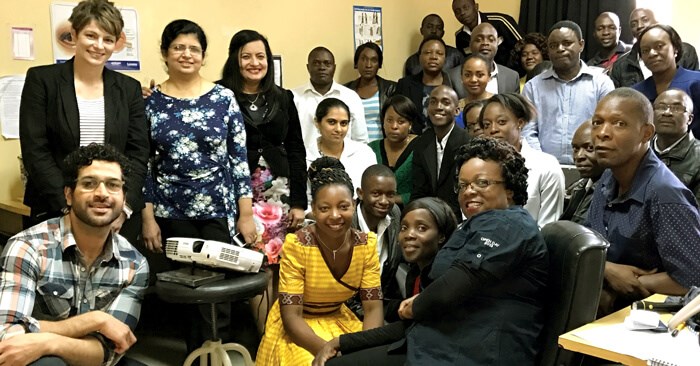
The Frimley Park LINK team with screener / graders during a training session in Zambia.
National blindness surveys
a) The Gambia
CEH developed and field-tested the World Health Organization (WHO) survey methodology for blindness and, with Hannah Faal, alumna of ICEH, in 1986, conducted the first African national survey in The Gambia (click here). This provided a baseline before Hannah and her team implemented the National Eye Care Programme (NECP). The NECP went out and found people with eye conditions, particularly cataract and trachoma, and brought them into the main hospital for surgery. Repeating the survey in 1996 provided evidence that implementing a national eyecare programme made a difference – it showed a 40% reduction in blindness in The Gambia over the 10 years [11]. A third survey in 2019 [12] revealed further progress in addressing blindness.
b) Rapid Assessment of Avoidable Blindness (RAAB)
From the mid-1990s, ICEH collaborated with Hans Limburg in the development of RAAB methodology as a population-based eye health survey [13]. It is used to assess the prevalence and causes of vision impairment and blindness among people aged 50 years and older, providing evidence enabling governments and non-governmental organisations (NGOs) to plan local and national eye health services. RAAB surveys now provide most of the global evidence for the prevalence and causes of blindness and vision impairment. The most recent version, RAAB7, is available digitally in collaboration with Peek [14] and collects data for tracking progress towards universal health coverage.
Influencing global health policies
a) Global programme for prevention of blindness
Learning from The Gambia was applied in the development of the global initiative ‘VISION 2020: The Right to Sight’, which was launched in 1999 to focus international efforts, including governments and NGOs, on reducing avoidable blindness worldwide [3]. ICEH expertise was critical in developing the strategy. Led by the WHO and International Agency for Prevention of Blindness (IAPB), the initiative adopted the key strategies of disease control, human resource development and infrastructure development [15].
Without the implementation of the strategies pushed forward by VISION 2020, it was estimated that there would be 76 million blind people worldwide by 2020. Following the implementation of VISION 2020, the actual number was 43 million. The combined efforts of governments, NGOs, professional bodies and the pharmaceutical industry working together brought about a dramatic reduction in avoidable blindness [16].
b) Lancet Commission on Global Eye Health
The Lancet Global Health Commission on Global Eye Health, led by Matthew Burton and Hannah Faal, was published in 2021 [17,18]. Drawing on expertise from within and outside the eye health sector, the commission set out to:
- Inform governments and other stakeholders about the path forward for universal eye health beyond 2020
- Further the achievement of the Sustainable Development Goals (SDGs)
- Work towards a world without avoidable vision loss
The systematic analyses carried out by the commission, and the novel research undertaken, shed new light on the shift from infectious eye diseases as a cause of vision impairment towards the greater contribution of chronic eye diseases, and the consequent need for refocused public health and clinical responses.
c) Promoting eye health as a global development issue
In 2021, for the first time, eye health was incorporated within the UN’s SDGs. The work of the Lancet Commission provided the clear evidence needed for the role of eye health in achieving several of the SDGs. The UN resolution set targets for ‘vision for everyone’ by 2030, calling for countries to ensure full access to eye care services and making eye health integral to the UN’s commitments to achieving the SDGs.
Capacity-strengthening
High-quality applied research carried out by ICEH and others in LMICs provides crucial evidence to build the knowledge base and drive innovation in eye health programming and prevention or treatment of specific diseases, with emphasis on LMICs. Using research results to inform policy and programme development in collaboration with governments and NGOs is a thread running through all the work of ICEH. As well as the articles in this issue of Eye News that highlight how applied research drives innovation in service delivery, below are further examples of some of the capacity-strengthening activities undertaken by ICEH.
a) VISION 2020 LINKS & Networks Programme: LINKS health partnerships
The LINKS Programme was established almost two decades ago to address the need for capacity-strengthening in LMICs through sharing the expertise of the whole eye health team in NHS hospitals with their LMIC counterparts. Forty LINKS have been established and have contributed to tangible improvements in eyecare services in 22 countries [19,20].
An example of a long-term LINK is the one between Zambia and Frimley Park Hospital, established in 2011, initially between Frimley and Kitwe Central Hospital and subsequently expanding to support strengthening of diabetic retinopathy (DR) screening and treatment services across Zambia in collaboration with the MoH. The LINK benefited from support and input from the senior leadership team at Frimley, including personal involvement and training visits from the then chairman, Sir Mike Aaronson, and chief executive, Sir Andrew Morris.
The Frimley Park LINK team have shared their expertise in training DR personnel by establishing further LINKS with St Lucia, India and Yunnan Province, China.
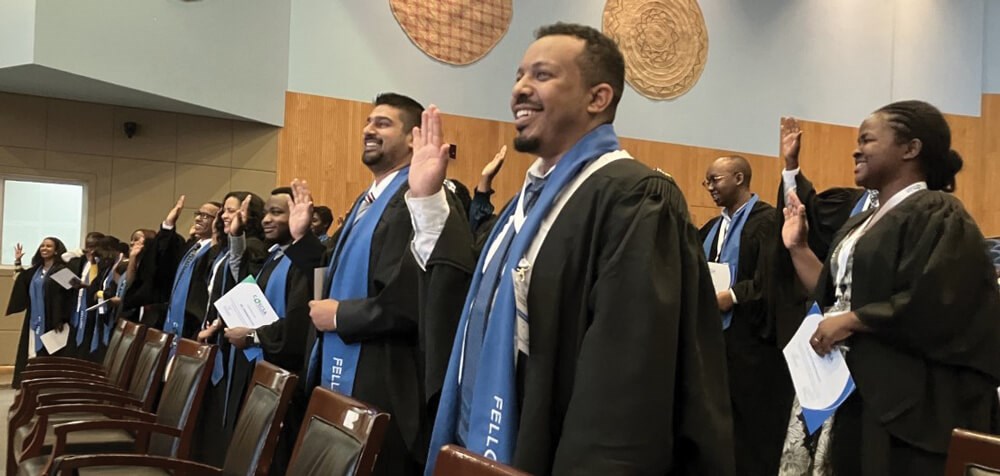
New graduates of COECSA taking the oath of the College in 2022.
The LINK between the College of Ophthalmology of Eastern, Central and Southern Africa (COECSA) and the Royal College of Ophthalmologists (RCOphth) was established in 2008. The goals of the partnership were to enhance ophthalmology training through:
- Developing fellowship examinations
- Harmonising the curriculum in ophthalmology training colleges
- Developing continuing professional development (CPD)
- Developing subspecialty training in the region
The benefits of the partnership have been felt across the 13 COECSA member countries in the region. The COECSA fellowship exam has gone from strength to strength since it started in 2010 [21,22]. It is taken by ophthalmologists in addition to their own training institution degree; it helps to standardise ophthalmology training across the region. Expertise and commitment of RCOphth members in this and many other aspects of COECSA’s work, including ‘Train the Trainers’, research capacity-building, enhancing the COECSA journal (JOECSA) and strengthening the annual congress, have all contributed to the development of COECSA as a powerful promoter of eye health in the region.
Networks over the last 10 years
LINK partnerships have been brought together into Networks. These have been established to address specific training and capacity-strengthening needs – to date these are DR (DR-NET), retinoblastoma (Rb-NET) and glaucoma (Glaucoma-NET).
Like LINKS, these take a whole-team approach; in the case of DR this includes endocrinologists or diabetologists; for Rb it includes oncologists, pathologists and counsellors. Representatives from the MoH in each country are important participants in the Networks to ensure that developments are integrated into national plans and policies. Whilst being built on health partnerships, Networks welcome other LMIC eye centres that do not have a LINK partnership.
a) DR-NET
DR-NET, the Diabetic Retinopathy Network, was launched in 2013 [23] in response to the huge need for screening and treatment to prevent unnecessary loss of sight through DR, one of the complications of diabetes, which is a growing problem in Africa. There are now 38 DR screening partnerships in the network, involving 22 countries in Africa, Asia, the Caribbean and the Pacific. Longstanding LINKS with a focus on medical retina and DR form the basis of the Network, with other centres joining to share learning south-south as well as north-south. The activities of DR-NET in each country are aligned with the national priorities of the MoH.
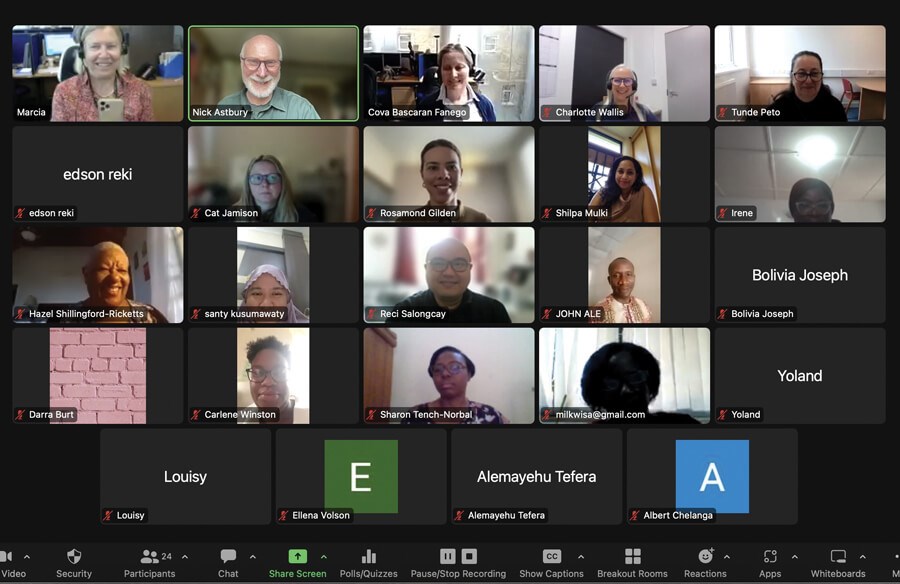
Screenshot of some of the participants in the GGR held in May 2023.
Key outcomes of DR-NET include:
- National DR frameworks and guidelines drawn up in Kenya, Tanzania, Uganda, Zambia and Botswana
- DR services expanded, or in some cases started, in 10 countries in Africa, the Caribbean and the Pacific
- The original goal of an extra 3750 people treated for DR by the partners between 2015 and 2019 was exceeded, with 8063 additional patients receiving sight-saving treatment [24].
DR-NET continues to bring its members together for regular workshops and Grading Grand Rounds (GGR) hosted via the website: www.dr-network.org
The ICEH LINKS & Networks team also works alongside national DR programmes, at the request of the MoH, to help in developing national DR guidelines and planning for their implementation, for example in Malawi and Nigeria [25].
b) Rb-NET
Rb-NET, the Retinoblastoma Network, strengthens capacity for Rb management in LMICs through workshops and online multidisciplinary team meetings (MDTs), sharing expertise within and between high- and low-income countries worldwide [26]. Its programme of national MDTs is hosted on the website: www.rb-net-mdt.org
Since they began in 2020, over 150 individual children’s treatment plans have been discussed during the MDTs, with 18 LMICs participating in regular national sessions. These empower Rb teams to optimise the treatment available in-country for these children. The Rb-NET is also a unique platform for global research, which is essential in a relatively rare disease. The Global Retinoblastoma Study Group has brought together the largest ever collaboration in Rb worldwide [27,28].
c) Glaucoma-NET
Glaucoma-NET was established in 2021 to improve the diagnosis and treatment of glaucoma, with the aim of preserving the sight of people with glaucoma in LMICs through knowledge-sharing and development of clinical services [29]. A comprehensive toolkit has been developed to help eye health professionals in LMICs to develop high-quality glaucoma services [33].
Through Glaucoma-NET, monthly online discussion meetings are held, which all eye health professionals with an interest in glaucoma are welcome to join. ICEH is also working alongside the Federal MoH in Nigeria to roll out the toolkit by establishing national guidelines for management of glaucoma in Nigeria and then helping to embed them [25]. The value of sharing ideas via this forum is highlighted by the article on raising community awareness of glaucoma in Uganda, featured in Eye News’ 2023 glaucoma supplement.
Community Eye Health Journal (CEHJ)
CEHJ was established at ICEH over 30 years ago. Its aim is to support eye health workers, managers and policy makers to help them reduce avoidable blindness and improve eye health. Four issues per year are published. Through charitable donations, paper copies are made available free of charge to eye health workers in LMICs. For many readers, the CEHJ may be their only regular up-to-date source of eye health information. It is available online at www.cehjournal.org and is discussed here.
Open education resources
ICEH produces a range of online courses available free of charge and covering many of the key topics in eyecare from a public health perspective, including glaucoma, diabetic eye disease and retinopathy of prematurity [31].
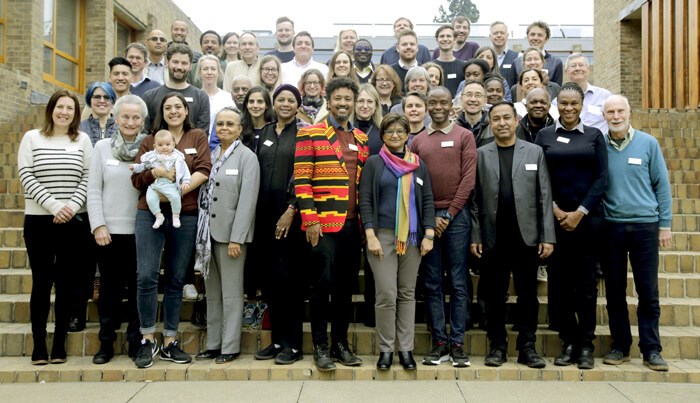
Summary
This article highlights some of the contributions that the staff, international colleagues and partners of ICEH have made, and continue to make, towards reducing unnecessary vision loss in LMICs. Its research, training and capacity-strengthening impact every level of the health system, from primary care to national policy, and across LMICs worldwide.
Many thousands of people in the UK and overseas are working alongside ICEH – connected through being an alumnus, reading CEHJ, participating in LINKS and Networks, involved in research, running blindness surveys and, crucially, as funding partners – together with a vast number of other organisations including the WHO, IAPB, governments and NGOs. All are united in the global effort to address the challenges eloquently expressed in the UN call to ‘leave no-one behind’ [32].
The uniqueness of ICEH is not so much what it has achieved as individual strategies, which many institutions do, but its ability to keep designing threads and creatively bringing them all together, enabling all participants to weave them into a vibrant, soft, but strong and lasting cloth, like the coat of many colours proudly displayed during the ICEH’s 40th anniversary gathering! (Pictured above)
References
1. International Centre for Eye Health.
https://iceh.lshtm.ac.uk/
2. International Centre for Eye Health. Masters.
https://iceh.lshtm.ac.uk/courses/#masters
3. Faal H. IN FOCUS - Prevention and treatment of blindness worldwide: the story of ‘VISION 2020: The Right to Sight’. Eye News 2020;26(6):8-10.
4. World Health Organization. Onchocerciasis.
https://www.who.int/news-room/
fact-sheets/detail/onchocerciasis
5. Tekle AH, Zouré HGM, Noma M, et al. Progress towards onchocerciasis elimination in the participating countries of the African Programme for Onchocerciasis Control: epidemiological evaluation results. Infect Dis Poverty 2016;5(1):66.
6. Solomon AW, Burton MJ, Gower EW, et al. Trachoma. Nat Rev Dis Primers 2022 May 26;8(1):32.
https://doi.org/10.1038/s41572-022-00359-5.
7. Mabey DCW, Solomon AW, Foster A. Trachoma. Lancet 2003;362(9379):223-9.
8. Gilbert C, Malik ANJ, Nahar N. Epidemiology of ROP update - Africa is the new frontier. Semin Perinatol 2019;43(6):317-22.
9. Gilbert C, Shukla R, Murthy GVS, et al. Retinopathy of prematurity: Overview and highlights of an initiative to integrate prevention, screening, and management into the public health system in India. Indian J Ophthalmol 2020;68(Suppl): S103-7.
10. Malik ANJ, Mafwiri N, Gilbert C. Integrating primary eye care into global child health policies. Arch Dis Child 2018;103:176-80.
11. Faal H, Minassian DC, Dolin PJ et al. Evaluation of a national eye care programme: re-survey after 10 years. Br J Ophthalmol 2000;84(9):948-51.
12. Hydara A, Mactaggart I, Bell SJ, et al. Prevalence of blindness and distance vision impairment in the Gambia across three decades of eye health programming. Br J Ophthalmol 2021;107(6):876-82.
13. Rapid Assessment of Avoidable Blindness.
https://www.raab.world
14. Peek Vision.
https://peekvision.org
15. Rao N. IN FOCUS - The achievements and lasting effects of VISION 2020. Eye News 2020;26(6):12-5.
16. Bourne RRA, Steinmetz JD, Flaxman S, et al. Trends in prevalence of blindness and distance and near vision impairment over 30 years: an analysis for the Global Burden of Disease Study. Lancet Glob Health 2021;9(2):e130-43.
17. Burton MJ, Ramke J, Marques AP, et al. The Lancet Global Health Commission on Global Eye Health: vision beyond 2020. Lancet Glob Health 2021;9(4):e489-e551.
18. Burton M, Faal H, Ramke J, et al. The Lancet Global Health Commission on Global Eye Health: vision beyond 2020. Eye News 2022;29(2):26-30.
19. Foster A, Onyango J, Nkurikiye J, et al. 6.6.2020 – a celebration of international partnerships. Eye News 2020;27(3):30-4.
20. Lavy T, Msukwa G, Waterson Wilson J, et al. Paediatric ophthalmology training in Malawi through the VISION 2020 LINKS Programme: a decade of partnership. Eye News 2016;23(4):50-3.
21. Costello D, Gachago M, Onyango J, et al. VISION 2020 LINKS: COECSA Fellowship examination goes from strength to strength. Eye News 2019; 25(6): 20-5.
22. Mdala S, Nyirenda CN, Zungu T, et al. Africa makes strides in tackling blinding eye diseases: highlights of annual conference. Eye News 2022;29(4):30-4.
23. Astbury N, Burgess P, Foster A, et al. Tackling diabetic retinopathy globally through the VISION 2020 LINKS Diabetic Retinopathy Network. Eye News 2017;23(5):30-4.
24. Zondervan M, Msukwa G, Onyango J, et al. IN FOCUS - VISION 2020 LINKS Programme: the contribution of health partnerships to reduction in blindness worldwide. Eye News 2020;26(6):18-24.
25. Okolo O, Nkanga D, Faal H, et al. Strengthening diabetic retinopathy services in Nigeria through DR-NET: from grass roots to national policy development. Eye News 2023;30(2):16-8.
26. Fabian ID, Astbury N, Nkanga E, et al. The role of virtual Rb-NET Multidisciplinary Team meetings in the management of children with retinoblastoma in low- and middle-income countries. Eye News 2021;27(6):36-8.
27. Global Retinoblastoma Study Group: Fabian ID, Abdallah E, Abdullahi SU, et al. Global Retinoblastoma Presentation and Analysis by National Income Level. JAMA Oncol 2020;6(5):685-95.
28. Global Retinoblastoma Study Group. The Global Retinoblastoma Outcome Study: a prospective, cluster-based analysis of 4064 patients from 149 countries. Lancet Glob Health 2022;10(8):e1128-40.
29. Kyari F, Ibanga A, Onakoya A, et al. Glaucoma-NET: a novel way of improving glaucoma management in sub-Saharan Africa. Eye News 2022;29(1):30-2.
30. Hu VH, Bassett H, Wolvaardt E. The Community Eye Health Journal. Eye News 2023;30(2):25-6.
31. International Centre for Eye Health. OER Courses.
https://iceh.lshtm.ac.uk/oer-courses
32. United Nations Sustainable Development Group. Operationalizing Leaving No One Behind (2022).
https://unsdg.un.org/resources/
leaving-no-one-behind-unsdg
-operational-guide-un-country-teams
33. The International Agency for the Prevention of Blindness. The first Toolkit for Glaucoma Management in Sub-Saharan Africa (2021).
https://www.iapb.org/learn/resources/
the-first-toolkit-for-glaucoma-management
-in-sub-saharan-africa
[All links last accessed June 2023]
COMMENTS ARE WELCOME




